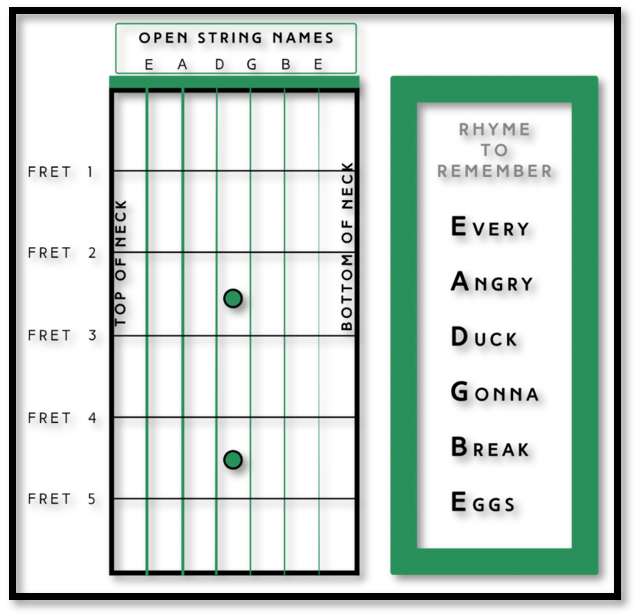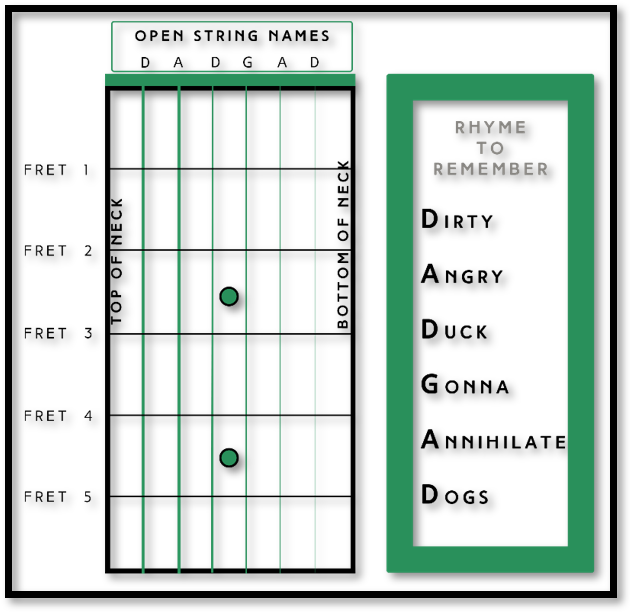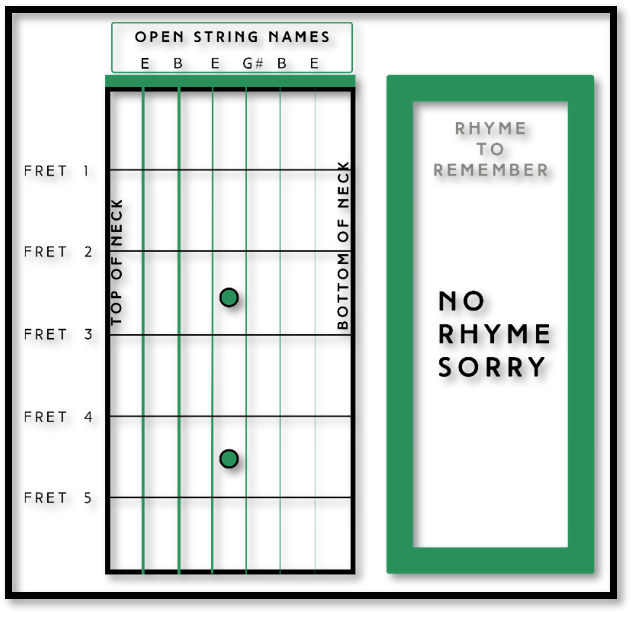What is the order of guitar strings?
Summary
Here’s the summary of the topics covered in the article below to help you get more insight to know the answer to "What is the order of guitar strings?"; just in case you’re too busy right now! When you get time just pop back and take a look in more detail!
I always refer to the order of guitar strings from the thickest to thinnest. Some people opt for the other way around but I always found it easier to go from the lowest pitch to the highest in pitch, it just made more sense to me.

Standard Tuning: E, A, D, G, B, E
For the following tunings, I’ve made the strings that deviate from standard tuning in bold and italic.
Drop D Tuning: D, A, D, G, B, E
DADGAD Tuning: D, A, D, G, A, D
E Major Open Chord Tuning: E, B, E, G#, B, E
Half Step Drop Tuning: Eb, Ab, Db, Gb, Bb, Eb
Full Step Drop Tuning: D, G, C, F, A, D
Main Article
This is a curious thing to discuss and all guitarists ponder this question, especially when they first start learning to play. I thought I would go through a few different angles on this topic by explaining some of the most common guitar string configurations and preferences.
Firstly, let’s go through the basic concepts before I dive into the specifics. If you’re asking which order the guitar strings go then we need to identify the start and end point first. If I think about the question of "What is the order of guitar strings?", then it is really important to define a few concepts here.
Throughout my years of playing, the majority of guitarists list the name of the guitar strings in order from thick to thin (from top to bottom when playing the guitar). I guess this is most likely due to the strings going up in pitch from the thickest to thinnest. Some instructors list the strings from thinnest to thickest but this is just counter-intuitive to me, for the reasons above. It’s personal preference when it comes down to it, so you choose which you prefer.
Guitar strings are assigned a letter, corresponding to a certain musical note. That’s because they are tuned to that musical note, get it? So, when you think about the notes/order of the guitar strings then all this means is the musical notes that they are tuned to. Which notes? It's up to you really.
I’m now going to go through a few of the different tunings and the string order of these, always going from thick to thin 😊.
Make sure you sign up to the Free Fret Success Academy www.FretSucccess.com if you haven’t already.
Standard Tuning
This method of tuning the strings is the generally accepted standard way that most guitarists go for. It’s also the most likely tuning that the songs you’ll be learning to play will use; at the start of your journey. From thick to thin (top to bottom) the string order and names are E, A, D, G, B, and E; see the diagram below and also the little funky rhyme to help you remember the order.
Standard Tuning Diagram

Drop D Tuning
The next tuning is normally the next one that you learn/become aware of, especially if you’re into rock/metal music. It’s a very simple concept to grasp, once you’ve understood and know the standard tuning when you think about the question, "What is the order of guitar strings?".
. All you have to do is drop (tune down) the top E string (top, very thickest string) by a tone/two semitones to make it a D note. This is where the Drop D comes from (dropping the E note to a D note). All of the other strings stay the same to standard tuning, so it makes it super easy to remember.
From thick to thin (top to bottom) the string order and names are D, A, D, G, B, and E; see the diagram below.
Drop D Tuning Diagram

A very easy way to get there, even without a tuner is to play the top thick E string and the D string together then tune the top thick E string down until it sounds the same as the open D string. Have a go at this. If you get stuck in drop D and want to get back to standard, there are two methods to get back; without using a tuner. These make use of the other standard tuned strings:
- Play the thin E string at the same time as the tuned down top thick D string (E string in standard tuning). Then tune the top thick E string (tuned down to D at the moment) back up so it sounds the same as the thin E string; or
- Fret the D string on the 2nd fret (an E note) and play this note at the same time as the top thick E string. Then tune up the top thick string (currently D string) to the same pitch as the string you’ve fretted to make it return to E.
Have you subscribed to the Fret Success Guitar Lessons YouTube Channel?
Click here to visit the YouTube channel and subscribe
DADGAD Tuning
This is a wonderful tuning!! It’s pretty much my favourite tuning, especially for acoustic playing; in particular percussive styles. It’s also a really easy one to grasp, especially if you’re in drop D already or understand the drop D tuning concept well; you may have already guessed how to get there. You normally describe it by the tuning of the notes, DADGAD (“DAD”, “GAD”). The string order goes from thickest to thinnest again D, A, D, G, A, and D.
It’s really easy to get there. All you have to do is tune the two E strings down by a tone/two semitones to get to DADGBD. So, from Drop D tuning all you need to do is drop the thinnest E string and you’re there! Then the final step is playing the Open A and B strings together and detune the Open B string until it sounds the same as the Open A. You just detune it by a tone (two semitones). Check out the rhyme for this one below!
DADGAD Tuning Diagram

Open Chord tuning
There’s no standard way to tune using this concept but don’t worry, it’s a really easy one to understand. It’s quite obvious really, all you do is tune all the open strings to the notes of a chord. The basic form of a guitar chord uses 3 notes, i.e. notes 1, 3 and 5 of the E major scale for the E major chord. As the guitar has six strings, we need to double up some of those notes to get a full open tuning of a chord. Let’s stick with the E Major open chord and tune to those notes.
So, the E Major Open Chord notes are E, B, E, G#, B, E; and ordered from thickest to thinnest. If we consider the standard tuning for a second, the A string, D string, and G string need to be retuned from that to form E Major Open Chord tuning.
Open E Major Tuning Diagram

The beauty of this method is that you can tune to any open chord you want, the most common ones being G Major Open Chord, D Major Open Chord and A Major Open Chord. Go give them a try and see which you prefer.
Half/full step drop tuning
The final string tuning I’ll take you through is one that guitarists use for multiple reasons including:
- Giving a lower end to the guitar sound i.e. changing the tone with a lower tension; and
- Making it easier to sing along with when playing songs in E scales.
It’s common to find this tuning used in rock and metal music, especially male singers; requiring a lower musical pitch to make vocal performance easier. However, it can also be used just to fit with any singer’s preferred vocal key.
If you’re struggling to play along with a track and you’re sure you have the transcription correct, then it is likely that the guitar was recorded with a drop tuning, such as half/full step.
There’s no quick and easy way to tune to half/full step drop tuning, so the easiest way is to use a tuner.
The following notes are used for half and full step drop tuning:
- Half Step: Eb, Ab, Db, Gb, Bb, Eb (your tuner might struggle with these so you can also tune to D#, G#, C#, F#, A#, D#, which are the same notes); and
- Full Step: D, G, C, F, A, D.
Half Step Drop Tuning Diagram

Full Step Drop Tuning Diagram

Cheers,
Dan
Founder
Fret Success

